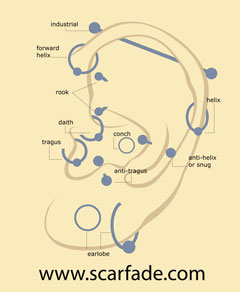
Piercing Scars
Different types of scars can form, including flat, hypertrophic, and keloid scars. The bump or ball is common in piercings with extremely low blood flow, like ear cartilage. There are several methods to removing scars from ear piercings that have gone wrong. They range from surgery to excise the bump to scar revision through a plastic surgeon to steroid injections to topical treatments with silicone scar removal products. For some, one solution is to simply wear their hair over their ears. Depending on the size and severity of the scar, a combination of any and all of these methods can be effective. Some more modern approaches with less scientifically proven results include pressure treatments, intralesional injection therapy (IIT) and chemical peels.
Closed Holes
After getting their ears pierced, some people change their minds about wearing earrings. When left unattended, the holes will eventually close over with the formation of new skin. The mark of the puncture may still be visible, however for several years. This can be treated with topical scar cream to reduce its prominence over time.
Earlobe Repair
In the case of a split or torn earlobe injury, the skin can be surgically repaired and sutured back together. Although a through-and-through injury will form a scar no matter what, plastic surgery can create a cleaner, slimmer line that may eventually go away with scar treatment after the surgical wound closes. It’s important to massage the area gently with the fingers to avoid thickening of the earlobe. Most doctors discourage their patients from re-piercing their ears in the exact same place. A waiting period of at least three months before choosing an alternate piercing location on the earlobe or cartilage area is recommended.
